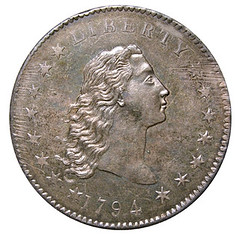
PREV ARTICLE
NEXT ARTICLE
FULL ISSUE
PREV FULL ISSUE
BILL ECKBERG ON THE NEIL-CARTER 1794 DOLLAR
Bill Eckberg submitted these further thoughts on the Neil-Carter-Terranova -Milas/Browder-Lustig-Contursi 1794 dollar (as Alan Weinberg dubbed it).
-Editor
Sometimes we get good deals, and sometimes we get bad deals. Nevertheless, you can see from his numbers that the rates of return are remarkably consistent, with only the 1986 sale at a loss as a minor outlier. While the numbers vary, numbers of this kind ALWAYS vary, which is why so many statisticians have jobs. The fit is surprisingly - even exceptionally - close, and quite remarkable because of it. I guess I'll also stir the pot and annoy more people who subscribe to the notion that coin was the "first". There is, in fact, no pedigree for the coin that goes back to anyone who was alive at the time the coin was struck. Therefore, it cannot possibly be known where this coin came among those issued. Accepting opinions that it is in an early state, we can guess that it was probably among the first several hundred. That the blank was first drilled and plugged would seem to me evidence that nothing about that planchet or coin was considered special at the time. If it were being handled specially as "The First", you'd think they'd have been able to dig out a better planchet. If it was really a "specimen" of what the dollar was to look like, the exact weight might not even have been an issue. In any case, let's not forget that the Mint had already struck a few hundred thousand cents and half cents before it got around to that one. The Mint was a workshop, and these coins that we carefully preserve and minister to today are a lot more important to us than they ever were to anyone in the Mint in the 18th century. There is no evidence that even the first Chain AMERI, which we know had to be the first real coin struck by the Mint, was saved or that we could identify it today, even if we wanted to. There is also no evidence that the first of any other variety was preserved. Dick Doty is absolutely correct in considering speculation about this coin being the first silver dollar struck to be in the realm of theology, not history and certainly not logic. But, hey, if it gives anyone pleasure and fulfillment to worship at the altar of this coin, go for it. My opinion is of little consequence.
Numismatists' opinions are only of little consequence when arguing with one's spouse (as I told my brother-in-law once, I had to get married to realize what I had in common with Abraham Lincoln and Albert Einstein - that to our wives, we're all complete idiots...) But in a land where logic has a spitting chance to prevail, every opinion counts. And in those many grey areas where the truth can never be fully known, the opinions of smart people are the best thing going, even when they conflict.
-Editor
To read the earlier E-Sylum articles, see:
MORE ON THE 1794 DOLLARS
(www.coinbooks.org/esylum_v13n23a17.html)
The Numismatic Bibliomania Society is a non-profit organization promoting numismatic literature. See our web site at coinbooks.org. To submit items for publication in The E-Sylum, write to the Editor at this address: whomren@gmail.com To subscribe go to: https://my.binhost.com/lists/listinfo/esylum All Rights Reserved. NBS Home Page Contact the NBS webmaster 
|
 Thanks to David Ganz for providing his numbers behind his graph of the price history of this coin. The (very minor) differences from my findings are due to his calculating the rate of return for each individual sale, whereas my graph uses a statistical analysis to show the history of the fair market value of the coin. As we all know, the actual sales prices of coins usually vary from what we would call the fair market value.
Thanks to David Ganz for providing his numbers behind his graph of the price history of this coin. The (very minor) differences from my findings are due to his calculating the rate of return for each individual sale, whereas my graph uses a statistical analysis to show the history of the fair market value of the coin. As we all know, the actual sales prices of coins usually vary from what we would call the fair market value.